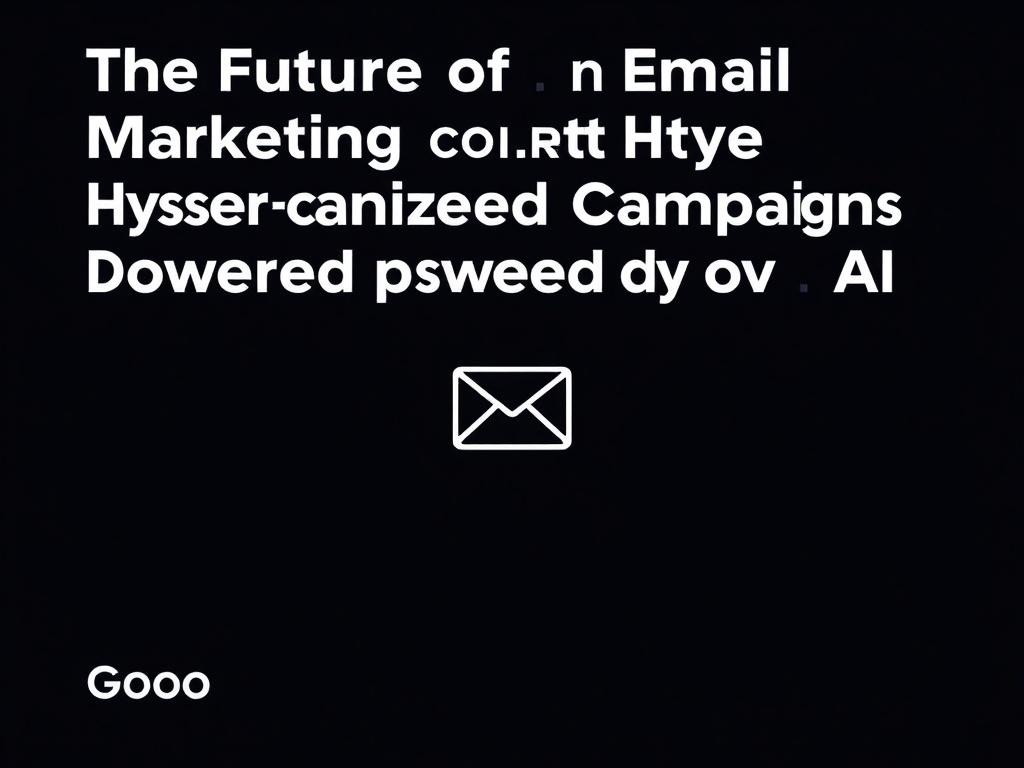Email marketing has been around longer than most digital channels, but it’s far from stale. In fact, it’s poised for one of the most radical reinventions in its history. Imagine messages that feel less like broadcasts and more like conversations, where every subject line, image choice, and send time is tuned to one person’s needs in real time. That future is already taking shape thanks to artificial intelligence. In this article I’ll walk you through how AI drives hyper-personalized email campaigns, what practical tools and techniques you’ll use, the ethical boundaries you must respect, and how marketers can prepare for this shift without getting overwhelmed.
If you’ve ever opened an email that seemed to read your mind — offering a product you were thinking about, timing a discount for exactly when you needed it, or using a tone that matched your mood — you’ve experienced the early version of hyper-personalization. With AI, those moments become systematic instead of accidental. But there’s a lot to unpack: data pipelines, model choices, content generation, measurement, privacy regulations, and the human skills needed to orchestrate it all. Let’s start by getting clear on what hyper-personalization actually means in practice.
What Hyper-Personalization Really Is
At its simplest, hyper-personalization is the practice of tailoring email content, timing, and experience to the individual recipient based on real-time data and predictive insights rather than broad segments. It goes beyond “Hello, [First Name]” or sending offers on a customer’s birthday. Hyper-personalization uses a blend of behavioral data, purchase history, browsing signals, engagement patterns, and even contextual signals like current weather or location to shape highly relevant messages.
This approach leverages AI to predict what a person is likely to do next, then serves the right content at the right moment. Instead of manually crafting dozens of segments, AI models infer micro-segments and personalize content dynamically. The goal is to increase relevance and engagement while reducing friction for the customer. When done well, it creates a win-win: customers receive value, and brands see higher conversion rates and stronger lifetime value.
How AI Makes Hyper-Personalization Possible
AI provides three major capabilities that turbocharge email marketing:
— Pattern recognition: Machine learning algorithms spot subtle correlations in large, messy datasets that human analysts would miss. For example, the combination of recent searches, time of day, and device type might predict purchase intent.
— Predictive power: Models can forecast future behavior — who’s likely to churn, who’s ready to buy, and who needs nurturing — enabling proactive campaigns rather than reactive ones.
— Real-time decisioning: AI systems evaluate data as it arrives and adapt content or timing on the fly. Instead of sending a static email to a list, you can assemble versions of that email per recipient at the moment of send.
These capabilities are applied across the email lifecycle: subject line personalization using NLP, content assembly using dynamic blocks, product recommendations via collaborative filtering, and send-time optimization using reinforcement learning. AI can also assist with creative variations, multilingual localization, compliance checks, and anomaly detection for deliverability issues.
Core Components of an AI-Powered Email Stack
To execute hyper-personalized campaigns, teams typically assemble an ecosystem of tools and processes. Below is a simplified breakdown of the main components and what each one does.
| Component | Function | Notes |
|---|---|---|
| Customer Data Platform (CDP) | Unifies customer profiles from multiple sources into a single view | Essential for accurate personalization |
| Data Warehouse / Lake | Stores raw and aggregated data for modeling and analysis | Supports training AI models and long-term storage |
| Machine Learning Platform | Builds and serves predictive models (churn, propensity, segmentation) | Can be cloud-based or on-premise |
| ESP with Dynamic Content | Executes sends with dynamic content blocks and triggers | Must integrate with CDP and ML outputs |
| Real-time Decision Engine | Decides variants, recommendations, and timing at send time | Key for real-time personalization |
| Analytics and Attribution Tools | Measure performance, uplift, and lifetime value | Prefer multi-touch attribution for long-term ROI |
| Privacy & Consent Layer | Manages permissions, opt-outs, and compliance | Critical to manage risk and customer trust |
This stack allows teams to move from raw data to individual-level decisions executed through email at scale. Integration between these components is often the hardest part — data schemas, APIs, and event streams must be consistent and reliable.
Data: The Fuel for Personalization
Data quality matters more than volume. A handful of reliable signals — recent browsing, last purchase, email opens, time of day preference — can outperform noisy bulk data. The kinds of data that matter most include:
- Transactional data: purchases, returns, cart value.
- Behavioral data: site browsing, app usage, email interactions.
- Contextual data: location, time, device, weather.
- CRM signals: customer service interactions, loyalty status.
- Third-party enrichments: demographics, interests (used carefully).
Collecting these signals in near real-time enables dynamic personalization. But remember: more data introduces more responsibility. Privacy-centric design and consent capture should be built in from day one.
Practical AI Techniques Used in Email Personalization

AI isn’t a single tool — it’s a toolbox. Here are the common techniques and how they apply to email marketing.
Predictive Modeling
Predictive models forecast outcomes like propensity to buy, churn risk, or next-best-action. These models use supervised learning techniques (logistic regression, gradient boosting, neural networks) trained on historical data. Results power targeted flows: win-back for high churn risk, cross-sell for high propensity, personalized offers for likely buyers.
Recommendation Systems
Recommendation engines suggest products or content tailored to each recipient. Collaborative filtering, content-based filtering, and hybrid methods are used depending on data availability. For example, a hybrid model could combine a user’s browsing history (content-based) with patterns from similar users (collaborative) to recommend products in an email.
NLP for Subject Lines and Copy
Natural Language Processing helps generate and optimize subject lines and email copy. Models can suggest tone variations, sentiment adjustments, and lengths tailored to user preferences. A/B testing combined with multi-armed bandits helps the system learn which styles work for which micro-segment.
Reinforcement Learning for Send-Time and Frequency
Rather than fixed send times, reinforcement learning models can optimize when and how often to reach a user based on feedback signals like opens and conversions. These models balance exploration (trying new times) and exploitation (using known successful times) to maximize long-term engagement.
Anomaly Detection for Deliverability
AI helps spot unusual patterns that could harm deliverability, like a sudden spike in bounces or spam complaints tied to a campaign. Early detection allows teams to pause or adjust campaigns before losing sender reputation.
Designing Emails for AI-Driven Personalization

AI can generate options, but designers and copywriters still steer the user experience. When designing templates for hyper-personalization, consider:
- Modular layouts: Build emails with interchangeable content blocks so AI can assemble personalized versions easily.
- Fallback content: Prepare default content when data is missing to avoid awkward gaps.
- Responsive personalization: Ensure dynamic blocks render well on all devices.
- Tone and brand safety: Limit AI-generated text to approved tone and vocabulary pools.
AI and creative teams should collaborate early. Feeding model outputs into creative review prevents off-brand messaging and exploits AI’s strengths (scale and data-driven relevance) while preserving human judgment.
Example: A Modular Email Template
Here’s a simple list of interchangeable blocks your template might include:
- Header: brand logo + personalized greeting
- Hero section: dynamic product or content recommendation
- Secondary offers: curated based on browsing or life stage
- Social proof: recent reviews or popularity indicators
- CTA block: primary, with secondary CTAs tailored by intent
- Footer: privacy preferences and unsubscribe link
This modularity lets the decision engine assemble the most relevant sequence for each recipient.
Measuring Success: New KPIs for AI-Driven Campaigns
Traditional metrics like open rate and click-through rate remain useful, but hyper-personalization requires broader metrics to capture long-term value.
| Category | Metric | Why It Matters |
|---|---|---|
| Engagement | Open Rate, Click-Through Rate, Reply Rate | Immediate signals of interest |
| Conversion | Conversion Rate, Revenue per Email | Direct business impact |
| Retention | Churn Rate, Repeat Purchase Rate | Long-term customer health |
| Lifetime Value | Customer Lifetime Value (CLV) | Measures campaign contribution to long-term revenue |
| Model Health | Prediction Accuracy, Drift Metrics | Ensures personalization remains effective over time |
| Privacy & Trust | Preference Center Opt-ins, Complaint Rates | Indicates customer comfort with personalization |
Attribution is key: multi-touch attribution and incrementality testing help isolate how much lift personalization contributes vs. other marketing activities.
Implementation Roadmap: From Pilot to Scale
Jumping straight into full-scale hyper-personalization is risky. Here’s a pragmatic roadmap to build momentum and de-risk the effort.
Phase 1 — Discovery and Data Hygiene
Start by auditing your data sources. Identify the signals you already have and the gaps. Clean duplicates, normalize formats, and ensure GDPR/CCPA consent is tracked. Establish a CDP or strengthen existing CRM integrations.
Phase 2 — Pilot Use Cases
Choose 2–3 high-impact, low-complexity pilots. Good examples:
- Send-time optimization for a subset of customers using historical engagement data.
- Recommendation-driven cart abandonment flow using collaborative filtering.
- Personalized subject lines tested via multi-armed bandit.
Run pilots on small cohorts and measure uplift in relevant KPIs.
Phase 3 — Modelization and Automation
Operationalize models that proved their value in pilots. Deploy reproducible model training pipelines, implement monitoring for drift, and embed model outputs into your ESP for automated execution.
Phase 4 — Scale and Governance
Scale to more segments and channels, introduce governance around data use, and formalize ethical guidelines. Integrate personalization across email, push, SMS, and onsite to create coherent omnichannel journeys.
Phase 5 — Continuous Improvement
Personalization is not a one-time project. Keep iterating, retraining models, and expanding signals. Use experimentation to validate hypotheses and measure long-term ROI.
Risks, Ethics, and Privacy Considerations
Hyper-personalization raises important ethical and legal questions. Customers appreciate relevance, but there’s a thin line between “useful” and “creepy.” Missteps can damage trust and brand reputation.
- Consent-first approach: Always get explicit, documented consent for data use that goes beyond basic transactional needs.
- Transparency: Make it clear why you’re sending personalized content and how customers can control it.
- Data minimization: Collect only what you need and retain data for the minimum necessary period.
- Bias and fairness: Audit models for biased outcomes that could exclude or mistreat certain customer groups.
- Security: Protect data both at rest and in transit. Have procedures for breaches and audits.
Regulatory requirements like GDPR and CCPA are non-negotiable. Build a privacy-by-design framework and give customers easy ways to view, download, correct, or delete their data.
Common Challenges and How to Overcome Them
AI promises a lot, but real-world adoption faces friction. Here are common challenges and practical ways to address them.
Integration Complexity
Challenge: Connecting CDP, ESP, data warehouse, and ML platforms can be messy.
Solution: Start with middleware or integration platforms that simplify connections. Standardize event schemas and use event streaming (e.g., Kafka) for real-time flows.
Data Quality and Silos
Challenge: Fragmented data leads to inconsistent personalization.
Solution: Invest time in data governance, master customer identifiers, and regular reconciliation. Use data contracts between engineering and marketing teams.
Skills Gap
Challenge: Marketing teams may lack data science or engineering expertise.
Solution: Hire or upskill for roles like machine learning product manager, data engineer, and model ops specialist. Partner with vendors for managed models while building internal capabilities.
Overfitting and Model Drift
Challenge: Models can degrade or overfit historical patterns.
Solution: Implement monitoring, regular retraining, and A/B tests for model changes. Use control groups to measure true lift.
Cost and ROI Uncertainty
Challenge: Investment in infrastructure and talent can be significant.
Solution: Start with high-impact pilots to prove ROI. Use incremental rollouts and focus on automations that directly influence revenue or retention.
Case Studies: How Brands Are Using AI in Email
Here are a few illustrative examples (anonymized and simplified) showing how companies apply AI-driven personalization.
Retailer: Intelligent Cart Recovery
A mid-sized e-commerce brand used collaborative filtering and purchase propensity models to build a cart recovery flow that recommended alternative products and offered personalized incentives only to those modeled as price-sensitive. The result: a 22% increase in recovered revenue and lower overall discount usage because incentives were targeted.
Media Company: Dynamic Content Based on Read-Time
A newsletter publisher analyzed reading patterns and time spent on topics, then used NLP to re-order article teasers in daily emails. Subscribers who opened early in the day saw different teasers than those who engaged in the evening. Engagement rose by 18%, and churn dropped.
Subscription Service: Send-Time Optimization
A subscription-based SaaS used reinforcement learning to optimize send times across thousands of customers. The model learned that enterprise users engaged more around late afternoons while freelancers opened during early mornings. Overall engagement improved and trial-to-paid conversions increased.
These examples show that the combination of predictive models and dynamic content often yields meaningful business outcomes when aligned with clear goals.
Tools and Vendors Landscape
The market for AI-powered email personalization is broad, ranging from all-in-one marketing platforms to specialized point solutions. When evaluating tools, consider:
- Data integration capabilities and available connectors
- Support for dynamic content and real-time API decisioning
- Built-in machine learning vs. ability to plug in your models
- Compliance features and data residency options
- Scalability and performance under peak loads
Common categories of vendors:
- ESP with AI features
- Dedicated CDPs
- Recommendation engine providers
- Model hosting and MLOps platforms
- Specialized agencies and consultancies
Choosing between full-service solutions and best-of-breed stacks depends on your team’s capacity and long-term strategy.
Building the Right Team
Successful AI-driven email programs require cross-functional teams. Typical roles include:
- Marketing Strategist: Defines campaigns, goals, and messaging.
- Data Engineer: Builds data pipelines and ETL for near real-time signals.
- Data Scientist / ML Engineer: Develops predictive models and recommendation algorithms.
- Product Manager (Growth): Prioritizes tests and ensures alignment with business goals.
- Designer / Copywriter: Crafts modular templates and brand-safe AI outputs.
- Privacy Officer: Ensures compliance and manages consent frameworks.
Collaboration and shared KPIs are the glue that keeps teams aligned. A small cross-functional pod can often deliver more than a siloed department.
Best Practices and Playbook
Here’s a practical checklist to follow as you adopt AI-driven personalization:
- Start small with clear hypotheses and measurable KPIs.
- Use modular email templates to enable dynamic assembly.
- Maintain data privacy and make opt-outs simple.
- Implement rigorous experiment designs with control groups.
- Monitor model performance and set retraining cadences.
- Keep humans in the loop for creative oversight and brand safety.
- Document data lineage and model features for audits.
- Invest in skills or partnerships for data engineering and MLOps.
These practices reduce risk and speed up learning cycles.
Looking Ahead: What to Expect in the Next 3–5 Years
The pace of innovation suggests several trends will become mainstream:
- Greater use of federated learning and privacy-preserving models so personalization can happen without centralizing sensitive data.
- More real-time orchestration across channels, where email is one node in an integrated moment-based journey.
- Smarter creative tooling that helps marketers generate compliant, on-brand copy and visual variations at scale.
- Stronger regulation and industry standards around transparency of automated personalization.
- Smaller brands accessing advanced personalization through managed AI-as-a-service offerings.
These changes will democratize personalization but also raise the bar for ethical governance and technical maturity.
Quick Checklist: Preparing Your Org for the Future
- Audit your data and fix identity resolution issues.
- Define the first three pilot use cases with clear success metrics.
- Invest in either an integrated platform or a modular stack depending on scale.
- Hire or train for 2–3 key roles in data and ML operations.
- Create a privacy-by-design policy and customer preference center.
Start with these steps to ensure you can capitalize on the AI wave without stumbling.
Final Thoughts
Hyper-personalized email campaigns powered by AI represent both an immense opportunity and a significant responsibility. The opportunity is straightforward: better relevance leads to higher engagement, improved conversions, and stronger customer relationships. The responsibility involves ethical data use, respecting customer preferences, and building systems that are transparent, secure, and fair.
The path to hyper-personalization is iterative. Begin with small, measurable pilots, focus on clean data and modular creative, and scale as models prove their value. Keep customers’ trust at the center of every decision — transparency and control are not just legal requirements, they are competitive advantages. When AI is used thoughtfully, email can become a deeply personal channel that feels human, not robotic. That is the future we should be building toward.
Conclusion

The future of email marketing is not about replacing human intuition with black-box algorithms; it’s about amplifying relevance through data-informed decisions while preserving empathy and brand voice. By adopting modular design, investing in data hygiene, running focused pilots, and establishing strong ethical guardrails, brands can deliver hyper-personalized experiences that respect customer privacy and drive measurable business value. The next wave of email will be less about mass blasts and more about meaningful, timely conversations tailored to each person — and AI is the technology that makes that transformation scalable.
